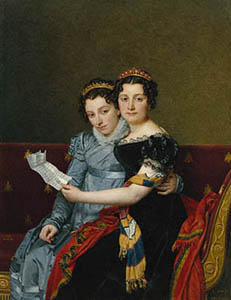• What can you read from the expressions on the faces of these two girls?
• By examining their clothing and surroundings, what can you tell about their social status?
• Who do you think is the more important figure in this portrait? What makes you think that?
• How would you describe the relationship between the two girls? What about the sitters helps you to draw those conclusions?
• Sometimes we can read a portrait just like we read people whom we meet in life. Speculate on what you think the story behind these two girls might be.
• Why do you think the artist chose to show them reading a letter? What do you think the letter is about? Do you think it might be good news or bad news? What can you see in the painting that leads you to that conclusion?
• A portrait including two people is called a double portrait. If you were going to have your portrait made with someone, who would it be? Why?
Extension for Working with the The Sisters Zénaïde and Charlotte Bonaparte
Before discussing the portrait, let the students examine it and write about what they think the letter might say. Have students share their letters with the class using their ideas as an introduction to discussing the portrait as a class. |
The sisters Zénaïde and Charlotte Bonaparte, Napoleon's nieces, embrace as they read a letter from their father, Joseph Bonaparte, who was exiled in the United States while they lived in Brussels, Belgium, after Napoleon's fall from power. The folds of the carefully creased letter are precisely rendered, and the viewer can even decipher the word "Philadelphia" across the top.
Jacques-Louis David contrasted the sisters' distinct personalities through their expressions and attire. The elder Zénaïde appears worldly and elegant in a low-cut dress of deep blue velvet. Sitting upright, she looks directly out at the viewer as she protects her younger sister, Charlotte. Charlotte appears timid as she shyly raises her eyes to look up at the viewer. She wished to become an artist and received drawing lessons from David. Both exiled princesses wear tiaras and sit on a red velvet couch embroidered with golden bees, the Bonaparte family emblem.
About the Artist
Jacques-Louis David studied drawing and translated literary classics before being accepted into the Académie Royale at the young age of eighteen. After eight years of struggle, he finally won the coveted Prix de Rome. Visits to ruins, exposure to Neoclassical doctrines, and study of the 17th-century French painter Nicolas Poussin's classicism encouraged him to adopt a style and subject matter derived from antiquity.
Returning to Paris in 1780, David soon prospered. Large canvases of classical themes brought him election to the Académie Royale in 1784 and sensational success at the Paris Salon in 1785. His firm linear contours, even lighting, pure colors, and frieze-like composition were admired, but it wasn't only his style that was revolutionary. The paintings came to be regarded as a political manifesto for ending the French aristocracy and returning to the stern, patriotic morals attributed to republican Rome.
David served in the French Revolutionary government, painted portraits of its leaders, designed its republican festivals and funerals, and suffered imprisonment when the political winds shifted. Despite his earlier impassioned rhetoric (e.g., "The artist must be a philosopher...an artistic genius should have no other guide except the torch of reason."), David handily transferred his loyalties to Napoleon Bonaparte, the new ruler of France. Exiled to Brussels after Napoleon's fall from power, David continued to train young painters and draftsmen.
|
